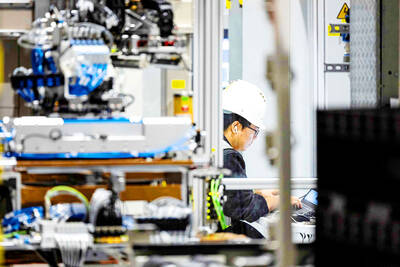With the US auto market worsening for Ford Motor Co almost daily, managers told union officials on Friday that the company will have to further reduce its factory work force in the coming months.
The slumping US economy has cut US auto sales by 8 percent during the first five months of the year, but it’s been a double hit on Ford, General Motors Corp and Chrysler LLC as consumers shun their high-profit pickup trucks and sport utility vehicles (SUVs) for more fuel-efficient models as they cope with US$4 per gallon (US$1.0567 per liter) gasoline.
United Auto Workers union officials were told in a meeting that Ford needs to make additional cost cuts “so that we can make the vehicles in an efficient way that customers are buying,” Ford spokeswoman Anne Marie Gattari said.
At the meeting, attended by about 300 executives, plant managers and union officials from across the US, Ford reiterated previous statements that it would make buyout and early retirement offers at targeted factories as it tries to further pare its payroll.
Union members declined to comment as they were leaving the meeting.
Gattari said Ford is still trying to determine which factories would get the offers, but prefers to use them over more dramatic steps such as closing factories.
“We have a lot of cost-cutting elements that we can work on together,” Gattari said. “We’re looking at doing those kinds of things before we do anything more drastic that no one wants to do.”
Ford said last month that it would cut production of trucks and SUVs, but increase factory output of cars and crossovers through additional shifts and overtime and the realignment of some of its manufacturing capacity. The company also said it plans to accelerate the North American introduction of some of its small cars from Europe and South America, although it didn’t reveal which vehicles.
Industry analysts have said Ford simply has too many factories making trucks for a market that even the automakers say has permanently shifted to vehicles that get better gas mileage. Many are operating with only one shift, which is inefficient, analysts said.
Also last month, Ford announced it would further cut its salaried work force.
“We have to do the same thing in our manufacturing operation,” Gattari said on Friday.
During the past three years, Ford has cut its hourly work force by about 40,000 in the US and Canada, she said.
Earlier this year, Ford had announced corporate-wide buyout and early retirement offers for US hourly workers, but only 4,200 took the offers, about half of what the company wanted.
Ford now is hoping more workers will take the buyouts.
“We need the help of our local union leadership to help make that happen,” Gattari said.

CHIP RACE: Three years of overbroad export controls drove foreign competitors to pursue their own AI chips, and ‘cost US taxpayers billions of dollars,’ Nvidia said China has figured out the US strategy for allowing it to buy Nvidia Corp’s H200s and is rejecting the artificial intelligence (AI) chip in favor of domestically developed semiconductors, White House AI adviser David Sacks said, citing news reports. US President Donald Trump on Monday said that he would allow shipments of Nvidia’s H200 chips to China, part of an administration effort backed by Sacks to challenge Chinese tech champions such as Huawei Technologies Co (華為) by bringing US competition to their home market. On Friday, Sacks signaled that he was uncertain about whether that approach would work. “They’re rejecting our chips,” Sacks

NATIONAL SECURITY: Intel’s testing of ACM tools despite US government control ‘highlights egregious gaps in US technology protection policies,’ a former official said Chipmaker Intel Corp has tested chipmaking tools this year from a toolmaker with deep roots in China and two overseas units that were targeted by US sanctions, according to two sources with direct knowledge of the matter. Intel, which fended off calls for its CEO’s resignation from US President Donald Trump in August over his alleged ties to China, got the tools from ACM Research Inc, a Fremont, California-based producer of chipmaking equipment. Two of ACM’s units, based in Shanghai and South Korea, were among a number of firms barred last year from receiving US technology over claims they have

It is challenging to build infrastructure in much of Europe. Constrained budgets and polarized politics tend to undermine long-term projects, forcing officials to react to emergencies rather than plan for the future. Not in Austria. Today, the country is to officially open its Koralmbahn tunnel, the 5.9 billion euro (US$6.9 billion) centerpiece of a groundbreaking new railway that will eventually run from Poland’s Baltic coast to the Adriatic Sea, transforming travel within Austria and positioning the Alpine nation at the forefront of logistics in Europe. “It is Austria’s biggest socio-economic experiment in over a century,” said Eric Kirschner, an economist at Graz-based Joanneum

France is developing domestic production of electric vehicle (EV) batteries with an eye on industrial independence, but Asian experts are proving key in launching operations. In the Verkor factory outside the northern city of Dunkirk, which was inaugurated on Thursday, foreign specialists, notably from South Korea and Malaysia, are training the local staff. Verkor is the third battery gigafactory to open in northern France in a region that has become known as “Battery Valley.” At the Automotive Energy Supply Corp (AESC) factory near the city of Douai, where production has been under way for several months, Chinese engineers and technicians supervise French recruits. “They